On the morning of February 2, I woke up early and after a quick breakfast, I went out and joined the Yamaroku folks under a dark gray sky that threatened rain. It was still early, but preparations were already well underway an hour before the start of the Kioke Summit.
At 9:00 o’clock, everybody gathered in front of the barrel-making workshop, and Yamamoto-san greeted the participants. Every year, manufacturers, brewers who use wooden barrel-aging fermentation, restaurant owners, distributors, retailers and media representatives gather for three days of kioke-making, lectures and business networking. Getting together here leads to new business opportunities and it’s a good chance to strengthen the community. New people are always arriving and leaving, so there is always a different lineup every day. What does not change is the fun and excitement.
After Yamamoto-san’s opening speech, it was Sakaguchi Naoto’s turn to explain the morning activity. Sakaguchi is Yamamoto’s partner and a master kioke maker and oversees everything which has to do with barrel-making. He said that, with everybody’s help, they were going to assemble a barrel that would be displayed at the upcoming Tokyo FoodEx in March. One of the best things about the Kioke Summit is that they try as much as possible to involve the participants, even when it comes to such specialized work as barrel-making.
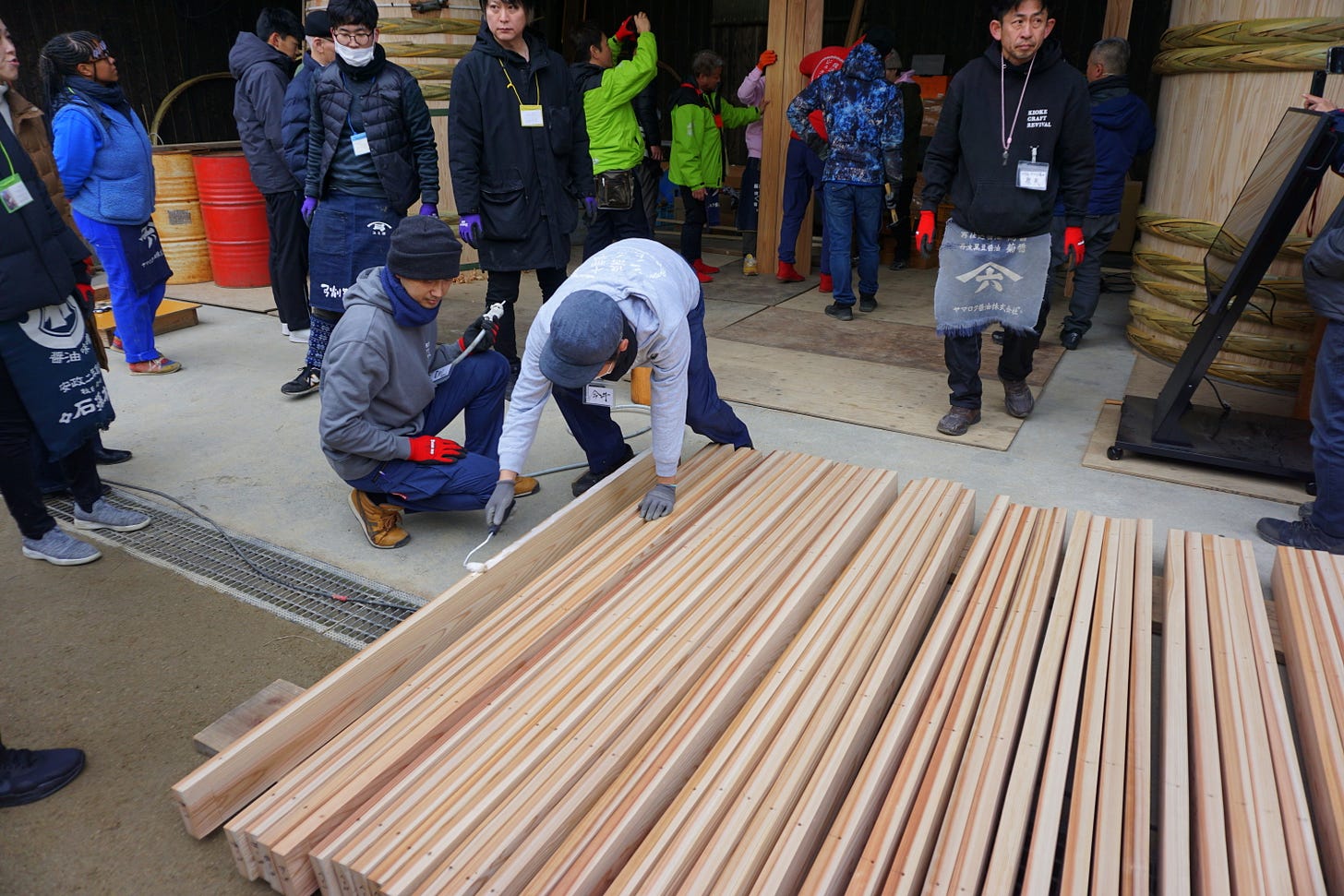
Sakaguchi started directing traffic and orchestrating the assembling of the staves, which are made of Yoshino sugi (Japanese cedar). The craftsmen hammered the nails into position, and slowly put the pieces together. Each stave had been marked with different letters and numbers. Since their sides are cut at an angle, they must be assembled in a certain order to obtain their round shape. Sakaguchi explained that only four decking boards can be taken from one tree, and each sideboard has its own individuality.
No iron nails are used to connect the side panels. Instead, they only use five or six bamboo nails, that's all. Those nails may be small but play an essential role in kioke making. If you use too much force, the bamboo will break, so you need to proceed with caution.
Yoshino cedar comes from Nara Prefecture, where good soil, rich nutrients and clean water are important to grow fine trees. Indeed, among the many kinds of cedar, Yoshino is highly valued because of its narrow-growth rings, perfect straight lines, lack of knots, and good color. It is also lighter and easier to process than oak or cherry. It takes about 100 years to grow a tree for a wooden barrel.
Yoshino cedars have long been grown to make sake and shoyu barrels. From the Edo period to the early Showa period (1600-1940s) that was their main purpose. The entire forest in Nara is artificial: it's 100% planted by man. One characteristic of these woods is how they are densely planted (8,000 to 10,000 trees per hectare). This allows for growing uniform rings. Thinning is also done on a regular basis.
Today’s 250-year-old forests have been managed through careful thinning for generations. That’s why, as Yamamoto points out, today’s kioke makers should never forget the foresight of people who planted those trees long ago.
Yamamoto is the rare case of a shoyu maker who makes his own barrels. In fact, he had to learn the craft out of necessity. Around 20 years ago, only one company was still making kioke in Japan. Yamamoto used to ask them to fix his barrels. Then one day he ordered a new one and was shocked to hear that the barrel maker was getting old and would soon retire. Moreover, barrel-making was going out of fashion: the kioke he was going to make for Yamaroku was the first order he had gotten since the war.
Yamamoto realized that lack of demand was causing kioke-making to disappear. Because of the spread of metal tanks, kioke artisans had gradually lost their livelihoods. Even today, the share of wooden barrel-brewed shoyu is only 1% of the market.
However, Yamamoto neither could afford to modernize nor wanted to. Both his father and grandfather had remained faithful to kioke because they made better-tasting shoyu. “My work is not making shoyu,” Yamamoto says. “I let the mold do its job. My job is to pass all this on – the brewery, the barrels and the mold – to the next generation. I'm indebted to my dad, grandfather and great-grandfather and have no choice but to carry on their legacy.”
Finding himself in a tight position, Yamamoto called his old school friend Sakaguchi and convinced him to join him in learning how to make wooden barrels. And the rest, as they say, is history.
Fast forward a few years, and not only Yamamoto and Sakaguchi have become expert kioke makers, but they are now passing on the age-old techniques they have learned. We gather around the craftsmen to admire their work. The cheering, clapping and shouting get increasingly frantic as the assembling nears completion. When the body of the barrel is finally ready, everybody gazes in awe at the huge object that, like a totem, stands before our eyes. Many people slowly surround the barrel and touch its smooth surface.
But the work is not done yet. Sakahuchi and his men put on a belt around the barrel and tighten it by turning the bolt. When you tap the barrel, they explain, you hear a "thump!" sound, but as you tighten the bolt and bring the side panels into closer contact, it changes to a high-pitched, beautiful reverberant sound.
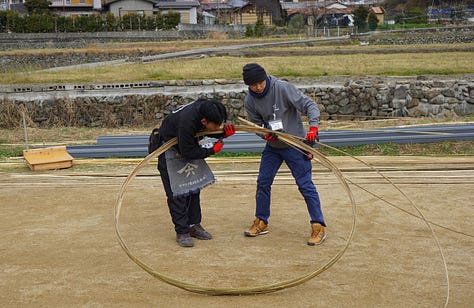
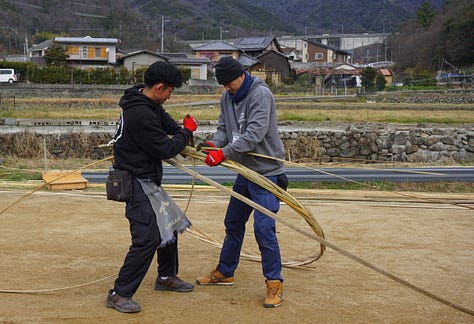
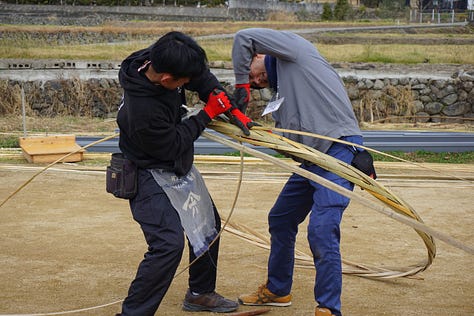
Now things were happening one after another. After recovering from the excitement of the barrel assembling, we moved to the open square near the fields where Yamamoto-san (on the left in the photos above) and one of his assistants showed how to weave a bamboo hoop. Each kioke is kept together by seven such hoops, or taga, as they are called in Japanese. Unlike metal, bamboo is resistant to salt corrosion and can last for as long as 100 years without deteriorating.
Taga-weaving is one of the most fascinating aspects of barrel-making and one of the hardest techniques to master. Each hoop is made of four thin bamboo strips that look like they are going to break at any moment. It takes a lot of practice to get it right.
Technique and experience are required to weave the hoop to the exact dimensions. And a lot of bamboo. For instance, in order to make a taga with a circumference of 5 meters, it takes three times as much bamboo – about 15 meters. First of all, it is hard to find bamboo of this length, and it's also difficult to cut straight strips of the same width that are thin enough to bend. Four strips are required to make one hoop, and seven hoops are put around one barrel. This means that one needs nearly 30 strips of bamboo for each kioke.
Observing Yamamoto-san and his assistant weaving a taga was like watching a ballet performance. They first weaved two strips together, then added two more in the middle. The sight of the two men bending and pulling the hard but flexible material was a sight to behold. In the hands of experienced craftsmen, the strips look very soft, like a ribbon. However, bamboo is extremely difficult to manipulate. If you use too much force to bend it, it will crack.
Later, Yamamoto explained that the hardest part of kioke-making is procuring bamboo. Even bamboo dealers don't have what barrel makers need, so they must find it themselves. “If not for my grandfather, I wouldn't be making barrels now,” Yamamoto said. “I remember asking a neighbor where I could find bamboo. He looked at me with a mixture of surprise and annoyance and said, ‘You idiot, your grandpa planted a whole bamboo forest on the mountain so you would never run out of bamboo.’ When I saw the forest with my own eyes, I was moved to tears.”
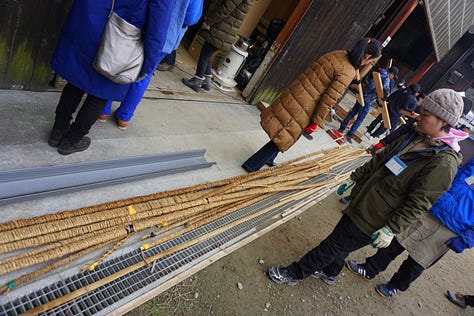
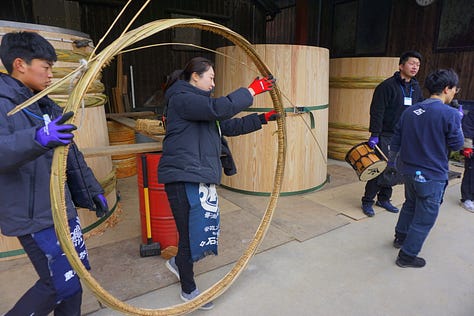
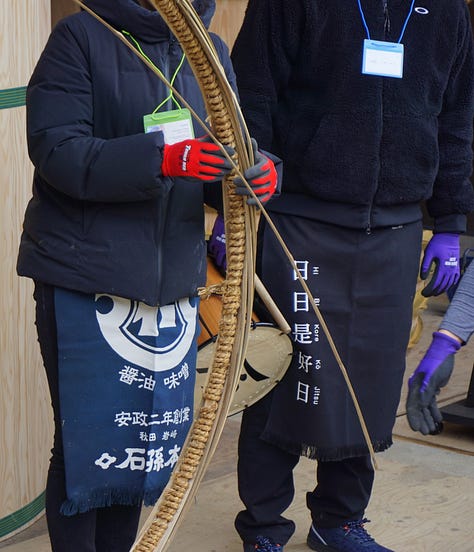
We would have spent the whole day watching the taga makers in action, but we were called by Sakaguchi: the time had come for all the participants – even first-comers like me who knew nothing about barrel-making – to give a hand.
Every taga hides a secret – a shin (core) that ensures that the hoop fits properly around the barrel. To make a shin, a rope is tightly wrapped around a thin strip of bamboo. Inserting the core inside the hoop increases its grip around the barrel. Without the shin, the hoop would move or slide off position, thus compromising the barrel’s shape and structure. In other words, though you can't see it, the shin plays a vital part in kioke-making.
I was told this fascinating detail by Takahashi Mantaro, one of the veteran members of the kioke shoyu community. Takahashi himself has a very interesting history. He left his office job to devote himself to traditional and local industries through his company, Traditional Design Studio Co., Ltd. He has visited over 400 shoyu breweries across the country, and now operates Shokunin Shoyu (Craft Shoyu), which sells high-quality shoyu in small 100ml bottles.
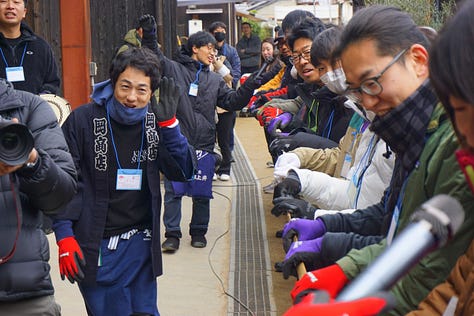
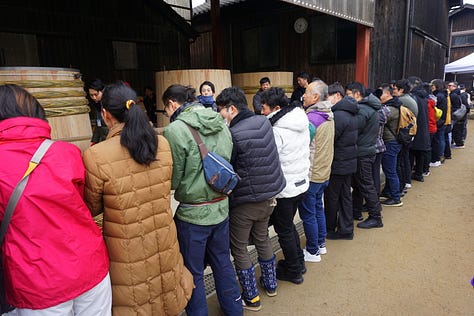
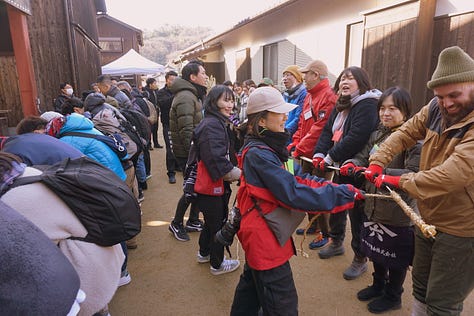
My conversation with Takahashi-san was interrupted by Yamamoto-san who wanted to get going with shin-wrapping. Groups of about 15 people were commandeered to form a line, put on workman’s gloves, and started turning the bamboo strip under the attentive gaze of the veteran craftsmen, cheered on by the excited cries from the other participants. Whenever things didn’t go as expected, Yamamoto-san would blow a whistle and pull out a yellow card like a soccer referee, criticizing us for our sloppy work or lack of enthusiasm.
Shin-making is not a particularly difficult task since you only have to turn the bamboo. However, it takes over 500 turns to make one core, and at the end, your hands hurt and your arms swell. Still, it makes for a good workout. Shodoshima in late January and early February is quite cold, and we spent the whole time outdoors, so such activities are a fun way to warm your body. Core-wrapping is also a lively, exciting activity, with lots of shouting, laughter, and even loud banging on drums. I ended up volunteering twice.
Humor and good vibes are part of the Kioke Summit, and the organizers always come up with funny gags to enliven the mood. So we were only slightly surprised when three tyrannosaurs burst onto the scene. They were quickly followed by a group of shoyu makers carrying a makeshift omikoshi (with a small shoyu barrel replacing the traditional portable Shinto shrine) and six ladies in bright-yellow chick costumes. Whatever the meaning, it made for a perfect ending to the hectic first morning of the festival. (To be continued)

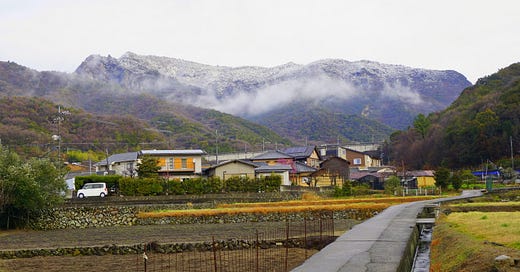



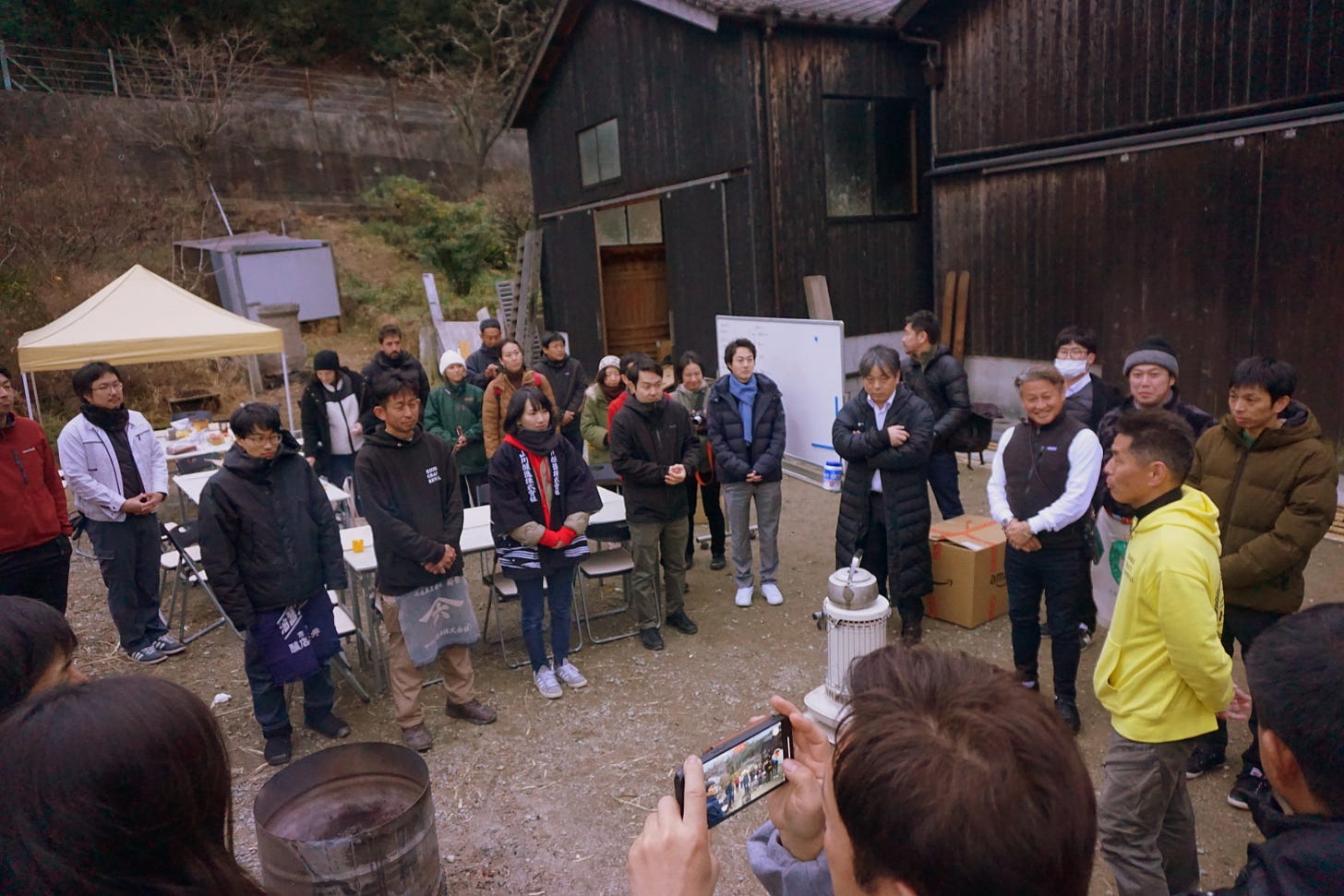
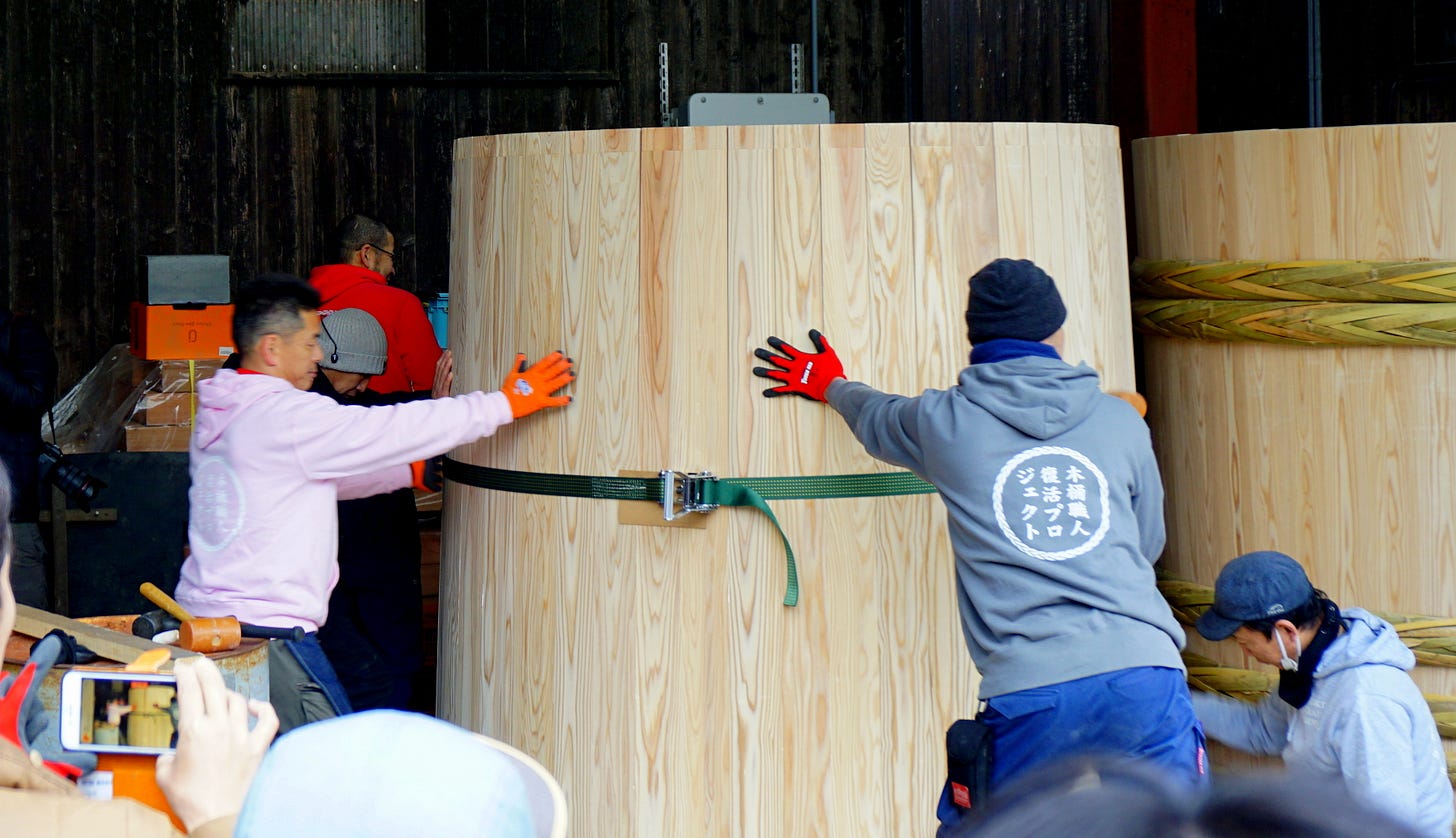
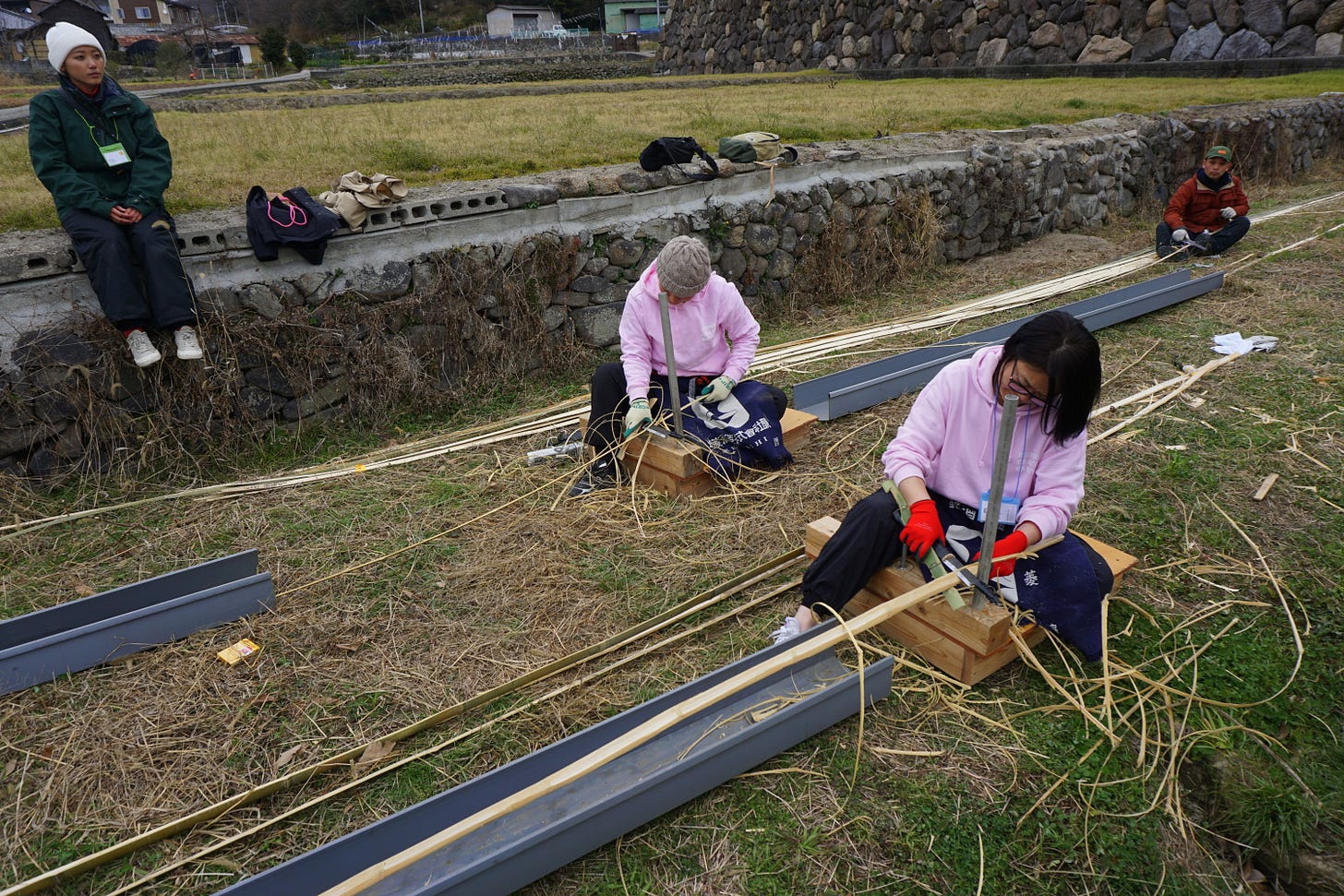
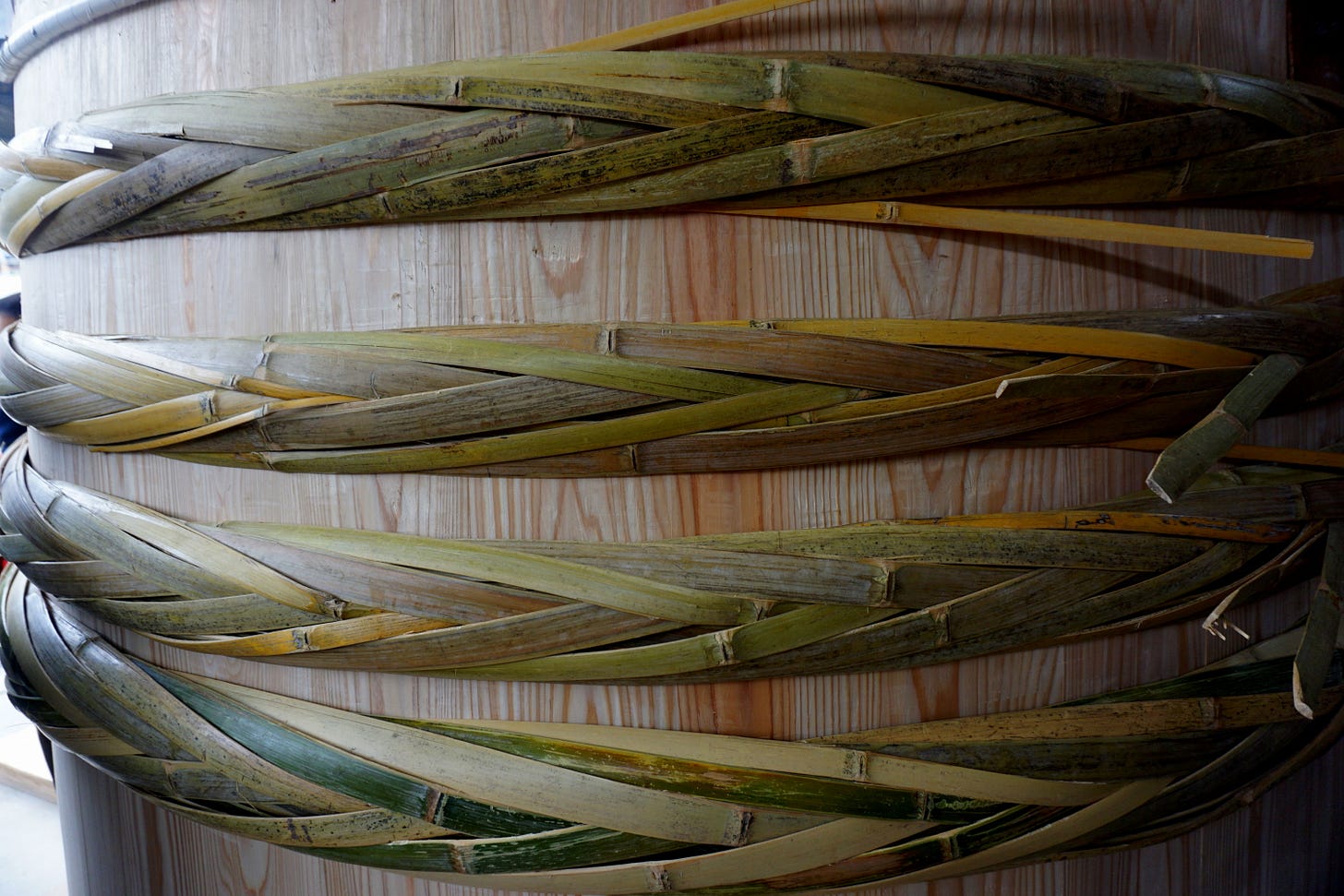
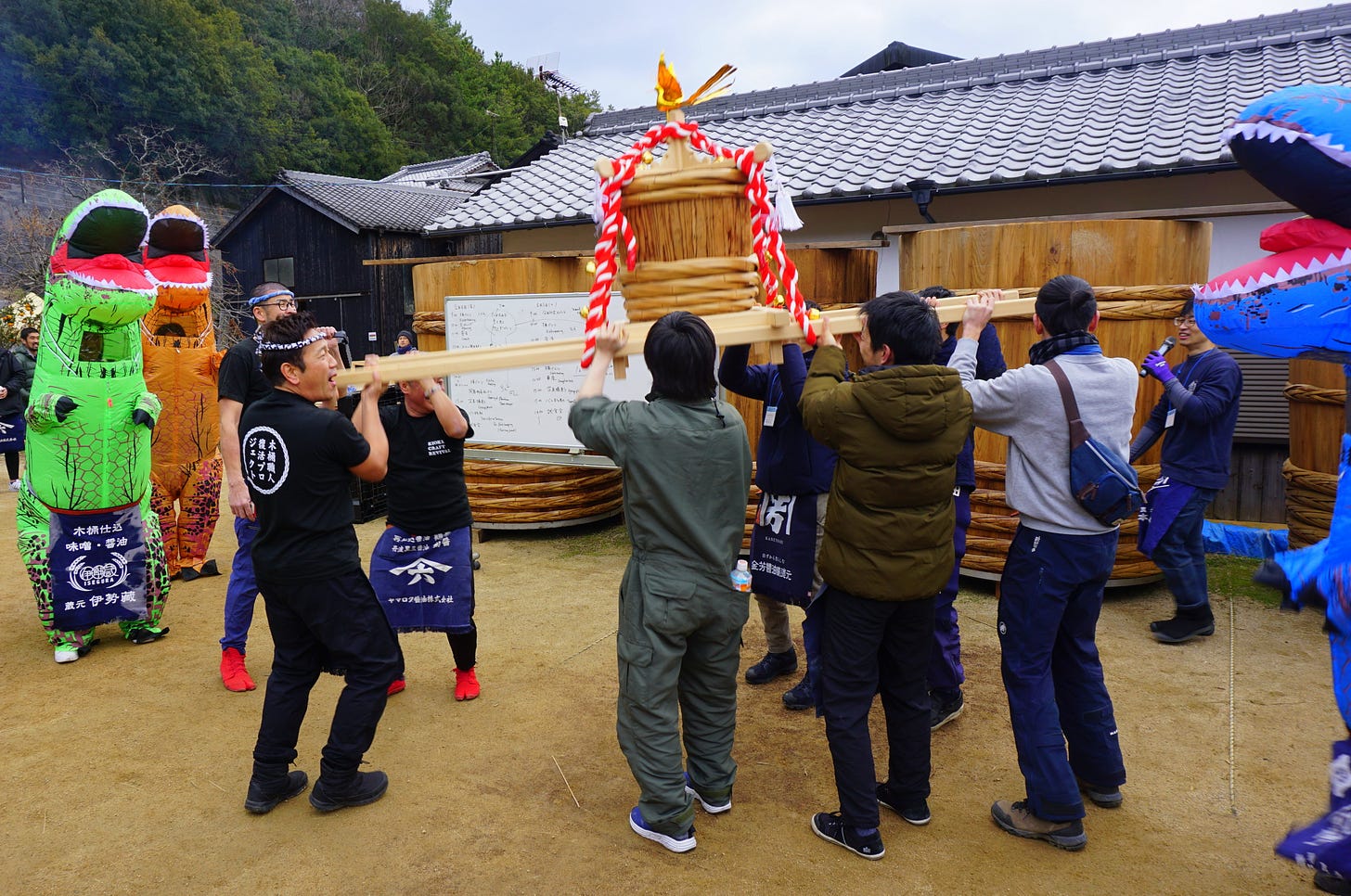
I wrote a kind of haiku:
"A drop of shoyu:
The barrel maker's good work.
Yoshino maple."
Thanks again, Gianni, for a great read!